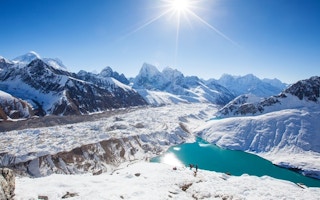Glaciers in the Mount Everest region of Nepal may almost completely disappear by the end of the century if carbon dioxide emissions continue to rise, warns a new research report published today in the European Geoscience Union journal.
The study estimates glaciers will reduce their volume by 70 per cent-99 per cent by 2100.
“The signal of future glacier change in the region is clear: continued and possibly accelerated mass loss from glaciers is likely given the projected increase in temperatures,” says Joseph Shea, a glacier hydrologist at the Nepal based International Centre for Integrated Mountain Development (ICIMOD) and leader of the study.
The study was carried out in Dudh Koshi basin of central Nepal, which contains 400 square kilometres of glaciers and includes Mount Everest and many of the world’s tallest peaks.
“
The signal of future glacier change in the region is clear: continued and possibly accelerated mass loss from glaciers is likely given the projected increase in temperatures.
Joseph Shea, glacier hydrologist, International Centre for Integrated Mountain Development
The researchers say glaciers will continue to melt because the freezing level – the elevation where mean monthly temperatures are 0°C – will shift to higher altitudes in the mountains as temperatures rise.
“The freezing level currently varies between 3200 m in January and 5500 m in August. Based on historical temperature measurements and projected warming to the year 2100, this could increase by 800–1200m,” added Immerzeel.
“Such an increase would not only reduce snow accumulations over the glaciers, but would also expose over 90 per cent of the current glacierized area to melt in the warmer months.”
The scientists say warmer temperatures will not only increase the rate of snow and ice melt, but also mean precipitation is more likely to fall as rain instead of snow, so the melted ice isn’t replenished.
The researchers predicted future scenarios based on field observations and analysis of data from local weather stations over the past fifty years.
“To examine the sensitivity of modelled glaciers to future climate change, we then applied eight temperature and precipitation scenarios to the historical temperature and precipitation data and tracked how glacier areas and volumes responded,” said another study co-author Walter Immerzeel of Utrecht University in the Netherlands.
Impacts on agriculture and hydropower
Meltwater from glaciers is an important source of water for much of the Himalayas. Changes in glacier volume will reduce the availability of water for agriculture and hydropower generation downstream, the researchers say.
The river basin is a major contributor to the Koshi River, for example, which accounts for almost a quarter of the potential for hydropower in Nepal.
Melting glaciers could also increase the risks of flood events for communities downstream. “Glacier retreat can also result in the formation and growth of lakes dammed by glacial debris. Avalanches and earthquakes can breach the dams, causing catastrophic floods,” added team leader Shea.
Scientists warn caution
The researchers caution that their findings should be seen as a first approximation of how Himalayan glaciers will react to increasing temperatures in the region.
“Our estimates need to be taken very cautiously, as considerable uncertainties remain. For example, the model simplifies glacier movements, which impact how glaciers respond to increases in temperature and precipitation,” said Patrick Wagnon, glaciologist at the Institut de Recherche pour le Développement in Grenoble, France, and the member of the study team.
The speed of glacier melt in the Himalayas has been fiercely debated. This is one of the few major scientific reports since Intergovernmental Panel on Climate Change (IPCC) fourth assessment report, which erroneously reported that Himalayan glaciers could disappear as early as 2035. The agency later admitted this was a mistake and published an apology.
The current status of glaciers varies across the Hindu Kush-Himalayan region, according to studies. While glaciers are retreating in most areas, glaciers in the Karakoram and Pamir ranges have remained stable or even gained mass.










